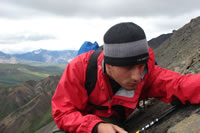
Eric Ricci ’08 writes about his field research in Denali National Park
Eric Ricci ’08 (Staten Island, N.Y.) is a geology major. He spent the summer researching fossils of the Late Cretaceous period during an expedition to Denali National Park in Alaska with David Sunderlin, assistant professor of geology and environmental geosciences. The following is a first-person account of Ricci’s experiences.
This summer I was fortunate to research in Denali Park, Alaska, with Professor David Sunderlin. We were gathering Late Cretaceous plant fossils from the lower Cantwell Formation. Our goal is to use the plants we find to model what kind of environment existed in Alaska over 60 million years ago.
The plants can help us obtain past climatic conditions, average mean temperature and rainfall, along with the knowledge of what plants were growing during this time in earth’s history. It was my first official research field season, and I believe the knowledge and experience I obtained from such a trip is vital to my growth as a field geologist.
The first step for this trip was meeting with Professor Sunderlin spring semester to discuss our plans for the trip. I read papers published by other scientists having to do with our project, quickly learning that there is so little known about Alaska because so much of it has yet to be scientifically explored and researched.
It was during this time I was able to learn about the trying, yet very important, research grant and park permitting processes. Next I needed to choose my gear for Alaska. Learning what equipment you need and realizing that at times all of it is going to be on your back is an important next step. We had to make sure we had the proper footwear, cooking equipment, enough food, a water filter, warm enough clothing and sleeping bags, ect. After all this was taken care of we finally got to leave for Alaska.
What may have been a bumpy start of sitting on the plane on the runway for seven hours, having to re-fuel before take off, missing our connecting flight and spending many unplanned hours at several airports led to both an amazing and successful experience.
After gearing up with geologic and topographical maps of the areas of interest, we first headed out for Sheep Mountain in the Talkeetna Range near the Matanuska Glacier. The climb to the summit was probably the most physically challenging part of the trip, and it whipped me into shape for the hikes and climbs to come. From here we headed through the Chickaloon Formation to check out some open pit mines which yielded meter wide fossilized tree stumps. It was only a few days after we arrived that we made it to our area of main study, Denali National Park.
During our time in the park we stayed in many different locations. While at headquarters we stayed in an apartment with other researches. We lodged in an A-frame at Tolklat camp, a cabin at the Denali Education Center, a yurt at Murie Science and Learning Center camp, and our own personal tents while in the field.
We collected fossils from many different locations in the park including Mt. Sheldon, Double Mt., Polychrome Mt., Soap Berry Patch, the Triple Lakes region and several others. Some of the different locales yielded more abundant fossils while others had a greater variety in plant types. We even found bivalve fossils and dinosaur foot prints on a trip to Sable Mountain.
We would label all the fossils with where we found them and at which location after wrapping them in newspaper. We would carry them back to camp with us and ultimately to headquarters where we would box them up and send them back to Lafayette to be prepped and studied this fall semester.
We saw such an amazing variety of wildlife while we were in the park. These included grizzly bears, caribou, moose, arctic ground squirrels, snow shoe hare, fox, golden eagles, and many more. The beauty of the park is unlike any place I have ever seen before, and often Professor Sunderlin and I would stop at the top of a mountain simply to take in the scenery and aesthetic beauty of a magnificent national park.
It was great working with Professor Sunderlin as I feel he has taught me so much and gave me an amazing opportunity to not just collect fossils in the field, but to study them back in the laboratory at Lafayette. Professor Sunderlin is not only a great teacher, but helped me apply classroom knowledge of geology while working in the field. While I was in Alaska I met many famous and highly respected geologists, paleontologists, and researchers who I also learned from, and now have as a resource in the future.
Waking up every day to eat oatmeal, munch on power bars throughout the afternoon, and ending the day with a freeze dried dinner, sounds bad to most. To me it meant we had a full day of hiking and fossil collecting under our belt. From gathering specimens to drawing stratigraphic cross sections, every day held something new and riveting.
I am excited to now take this project to the next step by prepping out the fossils here at Lafayette and to commence studying them. I will be working with Professor Sunderlin this semester in an independent study course called Paleo-Ecology. We will try to use the fossils that we found to fully understand the lower Cantwell Formation and use our research to collaborate with other researchers working in the area.
